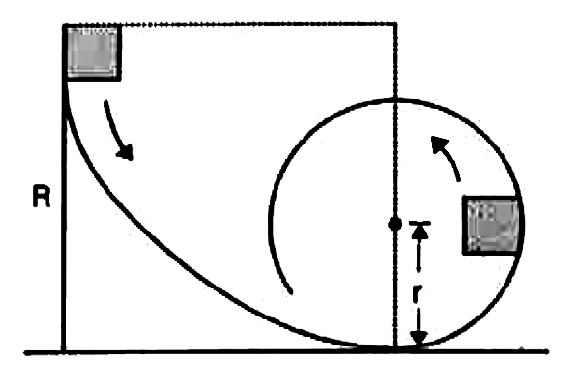Complete Solutions to Exercises (A) of chapter CENTRIPITAL AND CENTRIFUGAL FORCES of Class 11 book with complete answers and questions
| Class 11 | PHYSICS |
| Chapter | CENTRIPITAL AND CENTRIFUGAL FORCES |
| NN GHOSH | Exercises (A) |
| Number Of Questions | 18 |
| Academic Year | 2023-24 |
A bucket containing water is tied to one end of a rope 2 m long and rotated in a circle about the other end in a vertical plane. Find the minimum number of rotations per minute in order that water may not spill. `(g = 9.8 ms^(-2))`.
View SolutionA motor-cyclist goes round a circular race course ar 150 kmph. How far from the vertical must be lean inward to keep his balance if the track is 1.5 km long ?
View SolutionIn a circus a motorcyclist shows a trick of moving in a vertical plane without falling. Explain the physics of this track. What is the minimum speed of the motorcylist if the radius of the iron cage in which he shows his trick is 8 m ?
View SolutionA gramophone disc is set revolving in a horizontal plane at the rate of `33(1)/(2)` revolutions per minute. It is found that a small coin placed on the disc will remain there if its centre is not more than 5 cm from the axis of rotation. Calculate the coefficient of friction between the coin and the disc
[Hint : Centripetal force `= m omega^(2)r=` Frictional force `= mu N=mu mg`]
View SolutionThe CG of a loaded truck is at a height of 3 m above the ground and the distance between its wheels is 3m. What is the maximum speed with which it can go round a curved road of radius 200 m without turning turtle ?
View SolutionWhat is the maximum speed with which an automobile can round an unbanked curve of radius 200 m without skidding if the coefficient of friction between tyre and road is 0.3 ? `(g = 9.8 ms^(-2))`
[Hint : Centripetal force `= (mv^(2))/(r) = muN = mu mg`]
View SolutionCalculate the apparent weight if a body of 10 kg of place of latitude `60^(@)`. The radius of the earth `= 6.4 xx 10^(6)` m
[Hint : Apparent weight `= mg - mv^(2) cos ^(2) lamda/r` where `lamda` is the latitude of the place
`= mg - m omega^(2) r cos^(2) lamdaN`
`= (m - m omega^(2)r cos^(2) lamda//g)kg`]
View SolutionA small body is tied to an end of an inextensible string of negligible mass and length r, the other end being clamped to a rigid support. What is the minimum velocity with which the body must be projected horizontally so that it can go completely round a vertical circle without slakening of the string at the highest point ?
View SolutionAn artificial satellite is revolving in a circular orbit at a height of 600 km from the earth's surface. If its time of revolution be 100 minutes, calculate the acceleration due to gravity acting on it towards the earth. Radius of earth `= 6.4 xx 10^(6)` m
View SolutionA mass `m` on a frictionless table is attached to a hanging mass M by a cord length `l` passing through a hole in the table. Find the speed with which `m` must spin for M to stay at the highest point. If this speedis doubled, what will be the force with which M will press the table ?
View SolutionA road is banked correctly for a speed of 40 kmph. What is the maximum speed with which a car can negotiate the bend without skidding if the coefficient of friction between road and tyre is 0.3 and radius of the bend is 1 km ?
[Hint : `v_(m)^(2)=v^(2)+mu gr`]
View SolutionThe artificial satellite Aryabhatta was reported to revolve round the earth in 96.2 minutes at an average height of 600 km. With what velocity was it projected ? What was the acceleration due to gravity on the satellite ?
(Radius of the earth = 6400 km)
View SolutionThe bob of a simple pendulum of length 1m hangs at rest. It is suddenly projected horizontally with velocity `10 ms^(-1)`. Calculate the velocity of the bob and tension of the string when it is horizontal. The mass of the bob is `(1)/(2)`kg.
[Hint : See worked out example 4]
View SolutionA small brass bob is revolving in a horizontal circle with a constant speed of `2 ms^(-1)` at the end of a string of length 1 m. Find the time required for one revolution of the body. What angle does the string make with the vertical ?
View SolutionA roadway bridge over a rivulet is in the form of quarter of a circle of radius 60 m. What is the maximum speed with which a car can pass over the bridge without leaving the ground at any point ?
View SolutionA string of length 1m is fixed at one end and carries a mass of 1 kg at the other end. The string makes `2//pi` revolutions per second around a vertical axis passing through the fixed end. Calculate (i) angle of inclination of the string with the vertical, (ii) the tension in the strong and (iii) the linear velocity of the mass.
View SolutionA small block of mass `m` slides along a frictionless loop-the-loop (loop inside loop) track. What should be the ratio of the radius of the outer loop to the radius of the inner loop so that the the block may not lose contact at the highest point of the inner loop ?

View SolutionCalculate the height of the Apple (India's first geostationary satellite) above the surface of the earth (Radius of the earth = 6400 km and `g = 9.8 ms^(-2)`)
View Solution
Exercises (A) questions and complete solutions for chapter CENTRIPITAL AND CENTRIFUGAL FORCES of BHARATI BHAWAN PHYSICS (HINGLISH) of Class 11